Review: Nutcracker by E.T.A. Hoffman, illustrated by Maurice Sendak
Reviewed by Christina
[I received a complimentary copy of this book in exchange for an honest review.]
Published: 1984
It's about: Most of us are fairly familiar with the basic story of the ballet: little girl Clara gets a Nutcracker for Christmas, then has an elaborate dream in which he comes to life, defeats a rat king, turns into a prince, and takes Clara to a magical candy kingdom where she watches a sort of multinational (and somewhat culturally insensitive, by today's standards) ballet variety show. It's a classic Christmas tradition, set to Tchaikovsky's unforgettable score.
But until reading this beautiful hardcover edition I never realized that the ballet is actually a watered-down version of a much stranger, darker, and more complicated story by Romantic author E.T.A. Hoffmann. Here "The Nutcracker and the Mouse King" is translated from German by Ralph Mannheim and illustrated by the late, lamented Maurice Sendak.
I thought: Well, was this book a surprise! I read a few chapters each night to my five-year-old daughter, Isobel, and we finished it in a week. It is by far the most literarily advanced thing we've read aloud together, and I loved discovering with her this wide departure from the familiar ballet story. A good deal of plot probably went over her head- the language isn't always child-friendly, with fairly long and convoluted sentences and uncommon words like "roseate" and "scaramouche." (Although I should thank Hoffmann/Mannheim for the happy moment during the ballet when Isobel correctly identified hussars!) But still, if she were writing this review I know she'd have positive things to say and as a mom I have to give it some points.
Will we read it every year and love it again and again? I'm not sure. As much as I adore Maurice Sendak's books, the Nutcracker illustrations didn't thrill me. I suppose I'm too accustomed to the visual beauty of ballet accompanying this story; Mr. Sendak's characters are more straightforward and cartoonish. And sometimes they really don't accurately illustrate the physical attributes, settings, and action of the text. That was confusing, especially to Isobel. If Hoffman describes the prince as having a red coat, why is he wearing a purple one in the picture? And why are there all these beautiful but tangentially-related full-spread illustrations? I suppose, since I'm not an artist or illustrator myself, I don't understand the urge to depart so much from the text. The pictures, especially the full-spread ones, are very nicely done. But personally I would prefer them to be lavish and glistening.
Still, this is a good edition to look for if you want The Nutcracker's text as it was originally conceived, and if you are a big Sendak fan you'll probably appreciate his illustrations more than I did. I enjoyed it and I'm happy to have it in my family's collection of holiday books. And if my kids request it year after year, I will likely come to love it more passionately than I do now.
Verdict: Stick it on the shelf.
Reading Recommendations: I'd definitely recommend reading this a little bit at a time over the holidays, preferably with snuggly adorable children listening.
Warnings: Nothin'. Non-religious readers might not appreciate that this story is slightly more Christian than the ballet. Very young children might be frightened by some of the darker elements: mild peril, scary rats, toy battle sequences, disfiguring magic spells.
What I'm reading next: Still Les Misérables









